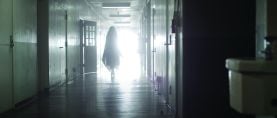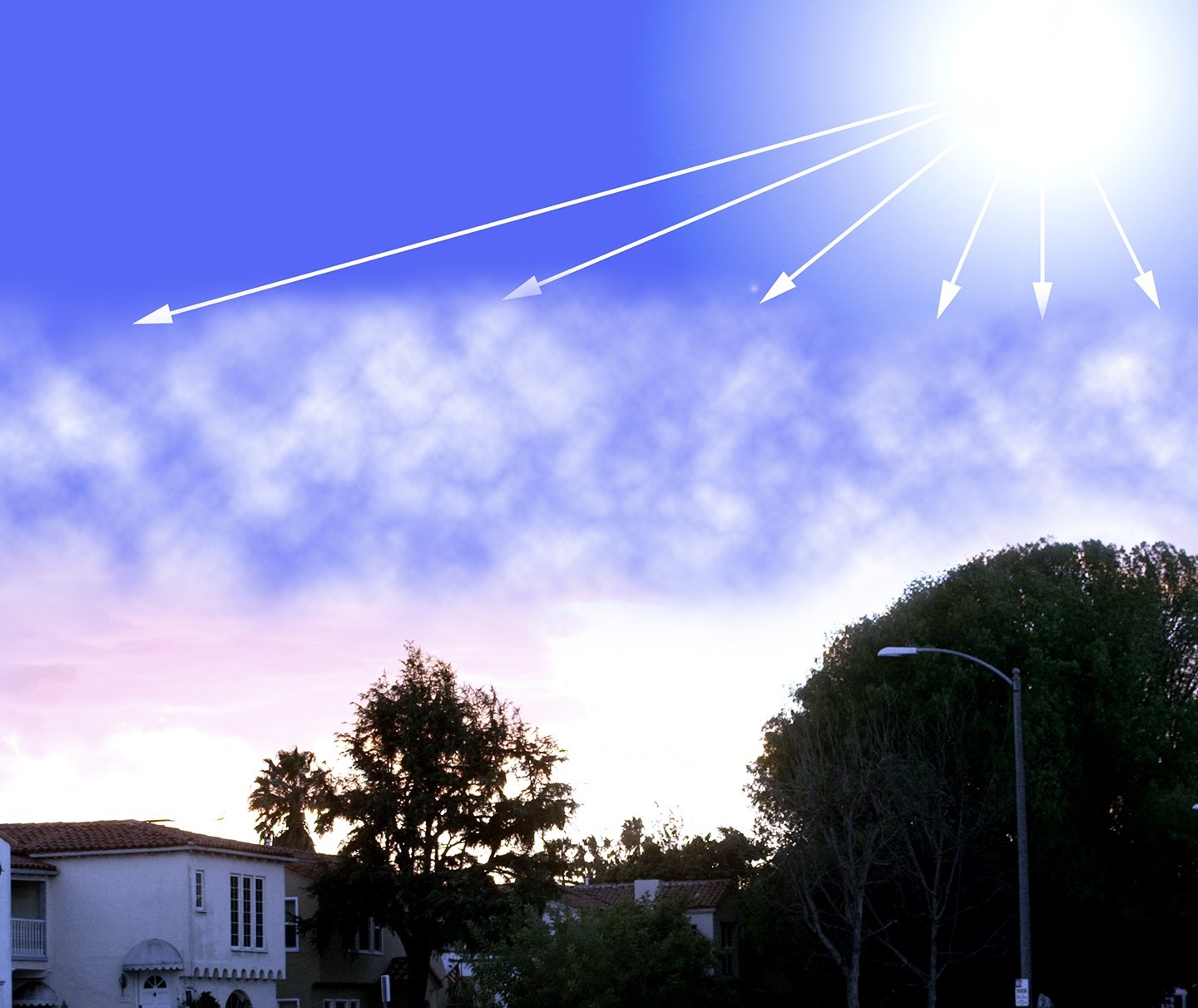
Light Quality 101
The primary characteristics of light that a cinematographer must learn to master are intensity, color and quality. Here we’ll take a look at the fundamentals of quality.

The primary characteristics of light that a cinematographer must learn to master are intensity, color and quality. Here we’ll take a look at the fundamentals of quality.
Light quality, which is generally described as “hard” or “soft,” is defined in terms of the breadth and nature of the transition between light and shadow — i.e., the “shadow edge transfer.” Does it transition from light to shadow in a sharp, well-defined manner, or is the transition more gradual?
The shadow edge transfer, or the overall quality of light, is determined by the size of the light source relative to its distance from the subject. This essentially means that once the physical size of the source is selected, controlling the quality of light then becomes all about controlling the source’s size relative to the subject.
Soft and Hard Light
The closer the source is to your subject, the softer the light will be. As light becomes softer, the shadow transition becomes longer and more gradual. Soft light is, by its nature, very low in contrast. It can be non-directional and even feel “sourceless,” meaning that it’s hard to determine what direction the light is coming from. It can hide the texture of an object, even at extreme angles. Extremely soft light can create a nearly shadowless environment.

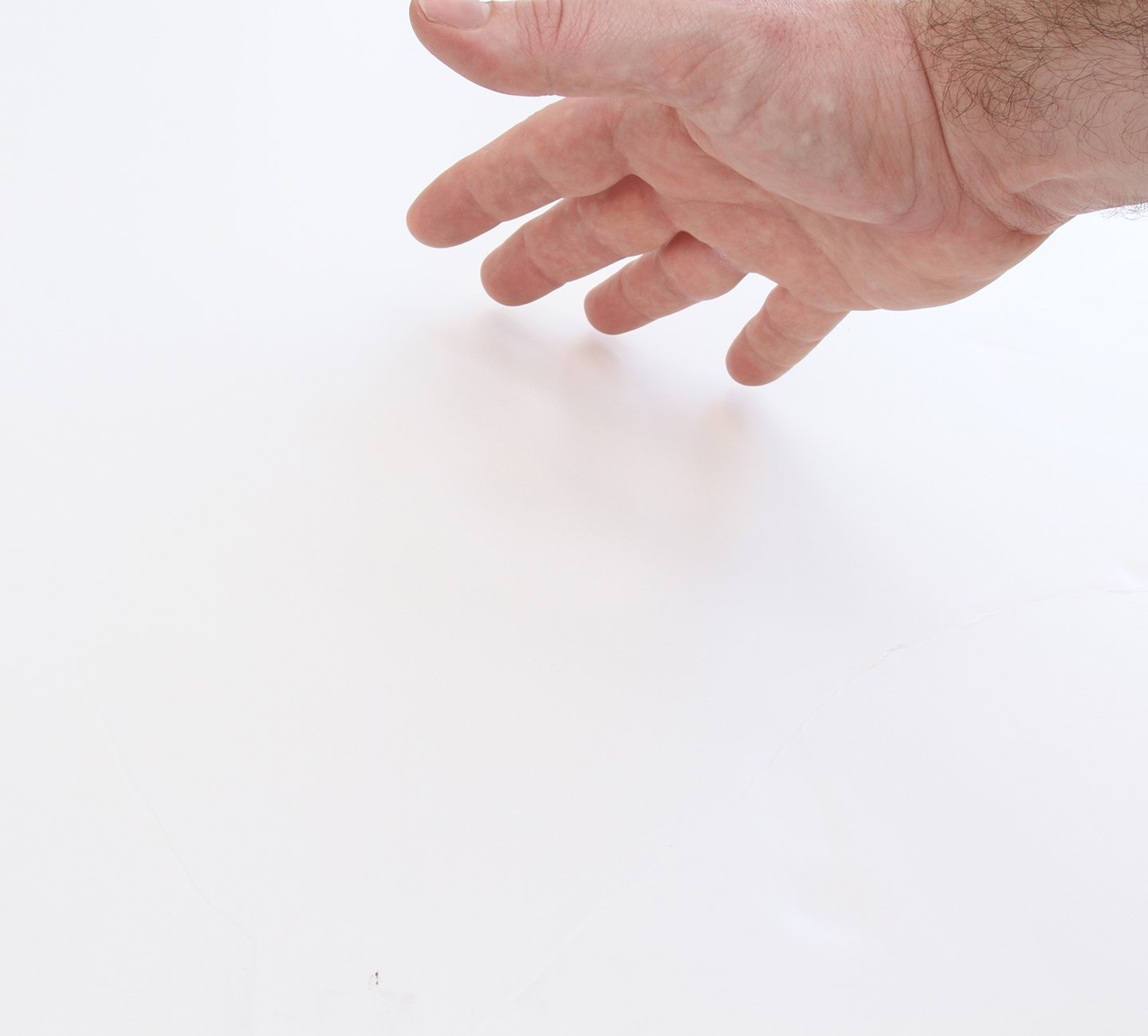
If you’re looking for a hard light, you need a small source as far away as possible. The smaller the source — physically or relatively, or both — the harder the light. Hard light has a very sharp, well-defined transfer from light to shadow. With hard light, we get very defined shadow shapes, and as it is high in contrast, it can create bright highlights and deep shadows. Depending on the direction of the light, it can reveal the texture of an object. If you rake (or sidelight) a hard light against a textured object, the light and shadows will distinctly define that texture.
Hard light is also very directional. Spotlights, for example, are hard sources — their beams are distinctly defined, and they can be focused to a very small area without spilling light onto other areas.
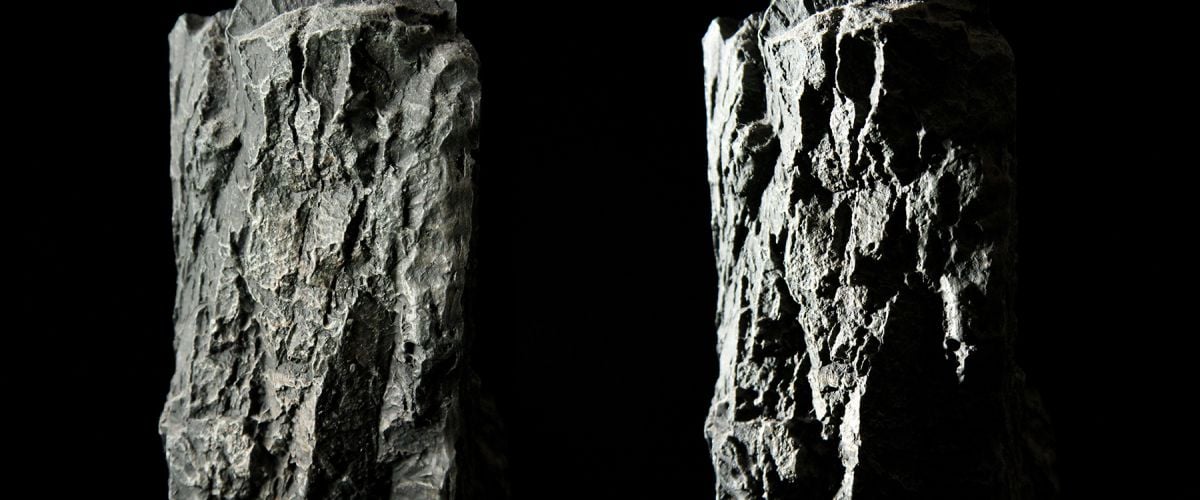
Controlling Light
The cinematographer’s job is just as much about what not to light as it is about what to light. Controlling unwanted light is crucial.
Hard light is easily controlled. Because of the sharp, well-defined shadows it creates, it’s fairly simple to place objects — such as flags — into its path to cut light off of areas you don’t want it to hit. The farther away the flag or cutter is from the light source, the sharper and more defined the cut will be. Just remember that even with a very hard light source, as you move the flag closer to the light, you’re allowing more light rays to scatter around the edge of the flag and soften the definition of the cut, which may or may not be the effect you’re looking for.
Understanding that, you should be able to visualize the effectiveness of barn doors on hard sources. Although they can be handy, they will not necessarily provide as sharp and defined a cut as a flag positioned away from the light. Barn doors are most often used for basic adjustments, whereas flags are best for fine ones.
Putting flags in front of a soft source, however, can be a lot like trying to stop an ocean wave with a 2x4. Because light is scattering in all directions, getting a clean, sharp cut from a soft source ranges from difficult to impossible. Controlling soft sources requires much larger flags, which can take up a lot of space. All said, once a soft source is placed, further control can be challenging to achieve.
Diffusion and Source Size
Perhaps surprisingly, the ability of diffusion materials to soften light is directly related to the principle that, all else the same, a larger source creates softer light. Placing in front of a light source a piece of diffusion that is larger than the source itself spreads the light over a larger area and increases the size of the source. In effect, the diffusion, like a cloudy sky, becomes the source. This is what softens the light.
Some young cinematographers make the mistake of thinking it’s diffusion on its own that does the softening; I’ve seen many clip a piece of diffusion to the face of a fixture in an attempt to soften the source. This might spread the light a bit, but it does not significantly change the light quality, because the size of the source — and its distance from the subject — remain the same. If the lens of the light is, say, 6" in diameter and the diffusion covers only that lens, you’re not increasing the size of the source. However, if the diffusion is a larger piece that is moved away from the light, you will change the size of the source and the quality of light. Even clipping the diffusion to the barn doors 6"-8" away can change light quality by increasing the size of the source. But if you want a truly soft light that fills the frame, you must place a larger piece of diffusion farther from your source.
A 20'x20' diffusion frame would seem to be an exceptionally large light source. Again, however, it needs to be large relative to the distance from the subject. If that same 20'x20' diffusion is 100' from your subject, it becomes a very small source and the quality of light becomes significantly harder.
Increasing the size of a source also happens anytime you bounce light off of material, as the bounce material itself effectively becomes the source. If you bounce a small, open-face fixture into a white ceiling, it becomes a soft overhead source.
For a look at the different ways that specific diffusion materials affect the light, see Shot Craft in AC Oct. and Dec. ’18.
The Inverse-Square Law & Photometrics
As there is a direct relationship between quality of light and distance to the source, we start to touch upon a law of physics called the inverse-square law, which states that the energy (of light, in this case) will diminish by the square of the distance traveled. For most lighting professionals, this is a rule used to determine falloff of a fixture at a specific distance. It is a great formula for determining the intensity you’ll get out of a fixture in your particular circumstance.
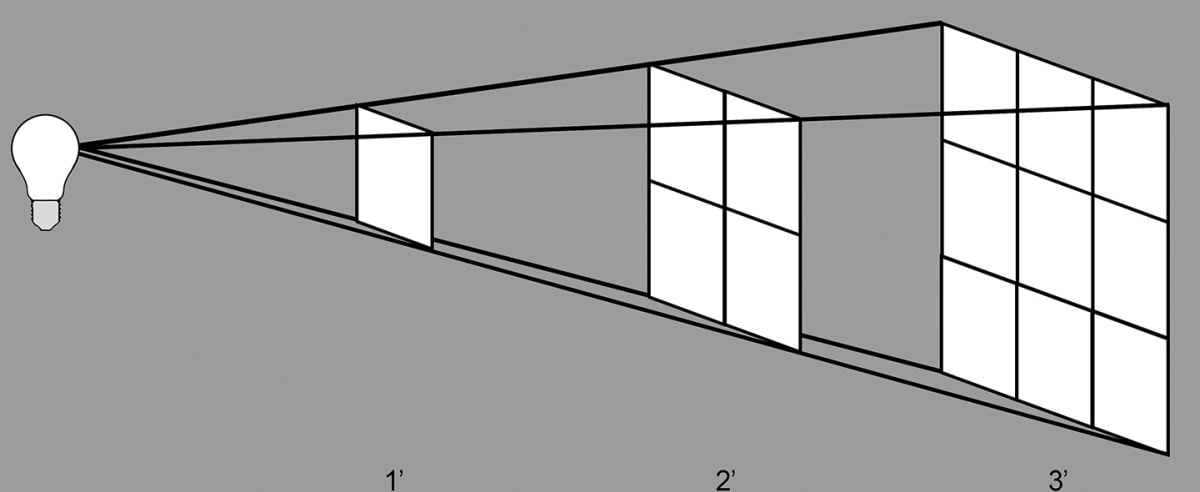
But this concept has other applications. In the simplest case, when you have a fixed distance between your fixture and your subject, using photometrics and inverse-square can help you determine the size of the fixture necessary to light your subject to a specific stop. Also, if you have a fixture that is providing too much intensity, knowing inverse-square can help you quickly determine how much light you can reduce by simply increasing the distance to the subject to obtain the intensity you want. For the mathematically inclined:
Intensity = 1/d2
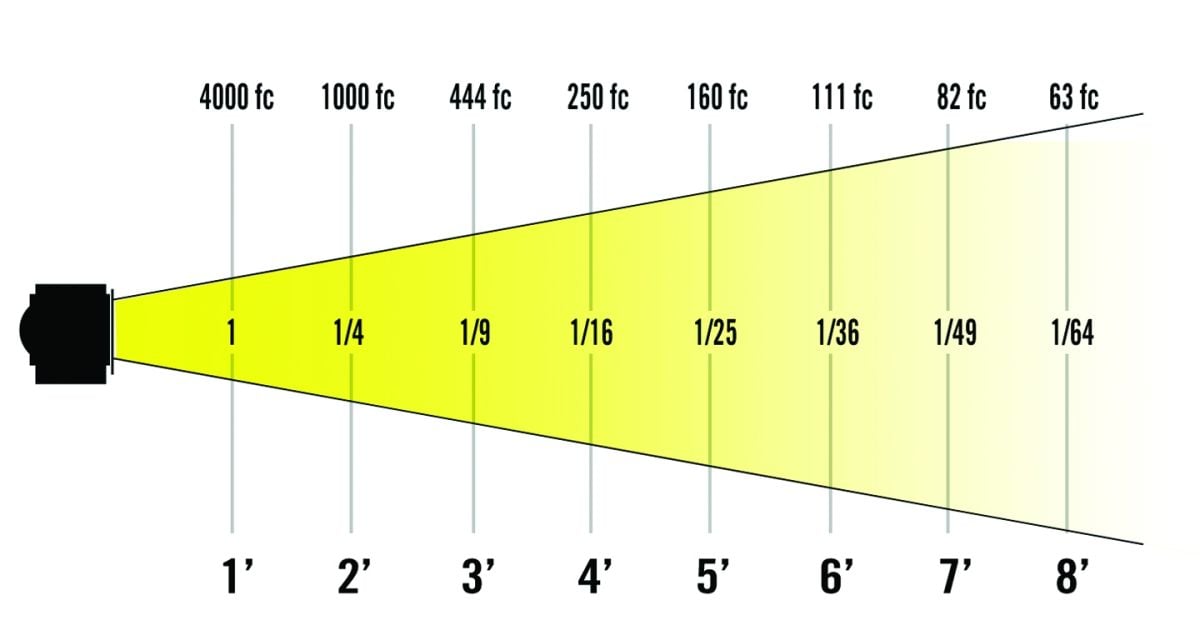
The formula and physics technically only apply to point sources; these are sources without lenses to focus the light, without diffusion, and that derive from a single point — like tungsten or HMI lamps, as opposed to fluorescent (a large light source that is not one point) or LED (a multiple-point source). The formula can, however, be applied to broader, softer sources as well, but the math will never be as clean. Softer sources will have a greater falloff than just the inverse square.
Looking at some photometrics for lamps, a typical 1K open-face fixture has an intensity of 1,000 footcandles of light at 4'. If we increase that distance to 8', our intensity drops to 250 fc. We have doubled our distance, but our intensity is now 1/4 (or the inverse-square the distance traveled) of the output.
If we look at the diagrams on pages 18 and 19, we see that as light rays diverge from a point source, they travel outward in all directions, and the farther they are from the source, the more they diverge and cover a larger physical area. So, at 1', what might cover a 1'-square area will at 2' cover a 4'-square area. At 3', that same light is spread over a 9'-square area. If we continued to 4', we’d see the light spreading over 16 square feet of area. So, from 1' to 4' the light has diminished in intensity 1/16 of its initial power because it is spread over that much more area.
When you’re dealing with a fixed subject — for instance, an actor sitting at a desk — the relationship of that subject to the light source doesn’t change. But if the actor becomes animated and leans forward in their chair, their relationship to the light source can change substantially. This is where understanding inverse-square can help you alleviate problems before they arise. If you’re lighting that actor with a fixture from 4' away and they lean forward, moving 1' closer to the fixture, they have changed their relationship to that light by 25 percent. Or, in inverse-square terms, there’s about a 50-percent increase in light intensity on the actor — definitely a noticeable brightness. However, if you move the fixture to 8' from the actor (and increase its brightness), then their movement of 1' is now only 1/8 or 12.5-percent increase.
This is also a situation where bigger is better. A 4' soft source at 4' has the same quality of light as a 16' source 8' away, but the spatial relationship to the subject is substantially different. (The intensity of the source behind the diffusion will need to increase to keep everything equivalent, but that’s a subject for another day.)
This also works for lighting groups of people: The farther away and larger the source is, the more evenly the light will spread on subjects — who, of course, will likely be at different distances from the source. Moving from 1' to 2' away from a fixture, there’s a fall-off of 75-percent light intensity, but moving from 11' to 12' from that same fixture creates a fall-off of less than 20-percent. Therefore, if you have the ability to create a 20' source and place it 20' away, then the intensity difference would be negligible between subjects at different distances, and the actors can move around within a substantial area without necessitating a change to light-intensity and exposure.
The practical lesson is that the larger and farther away the source is, the larger the area you can cover with relatively equal illumination from a single source. This is what I like to call the lighting inverse-square “dance.”
For more on photometrics and the inverse-square law, see Shot Craft in AC Dec. ’19.

Relative Size
When bringing the source closer to the subject — and thus softening the light — you are increasing the source’s size relative to the subject. To think about it another way, you could achieve a roughly equivalent softening of the light by keeping the same distance between the source and the subject, but replacing the source with a physically larger one of a similar type.
Sun and Sky
The sun is a gigantic source — a huge ball of burning gas 864,600 miles in diameter — however, it is also, on average, 92.96 million miles from Earth, which makes it a small point source in the sky. The sky encompasses a 180-degree hemisphere of our vision, and the sun makes up only .5 degrees. Light from direct sunlight is the hardest light we know. When it’s an overcast day, however, clouds encompass the 180-degree hemisphere of the sky, and the sun illuminates the full sky fairly evenly. In this case, clouds become the light source, which means the source is now 180 degrees rather than .5 degrees. The effect of this extreme example of soft light can be nearly shadowless.
For a discussion of sunlight vs. ambient skylight, see Shot Craft in AC June ’18.
Hard-Light Tech Tip
Open-face light sources with clear bulbs can create very hard light. A Fresnel fixture can create sharp shadows and, depending on its size, relatively hard light, but the nature of the lens itself diffuses the light to a degree, so if you want a really sharp shadow, you should remove the lens.
Soft Light Everywhere
Look around and you’ll see myriad examples of soft lighting in architectural situations. Interior designers are always looking for ways to soften light in rooms, making them more ambient and “sourceless.” This starts with lampshades, which are nothing more than decorative diffusers for standard light bulbs. There are also torchiere lamps, which direct hard light up to bounce off the ceiling and give the room a soft glow. Architectural designers often hide lights in recessed areas, bouncing them off walls to create a soft glow from a seemingly invisible source.

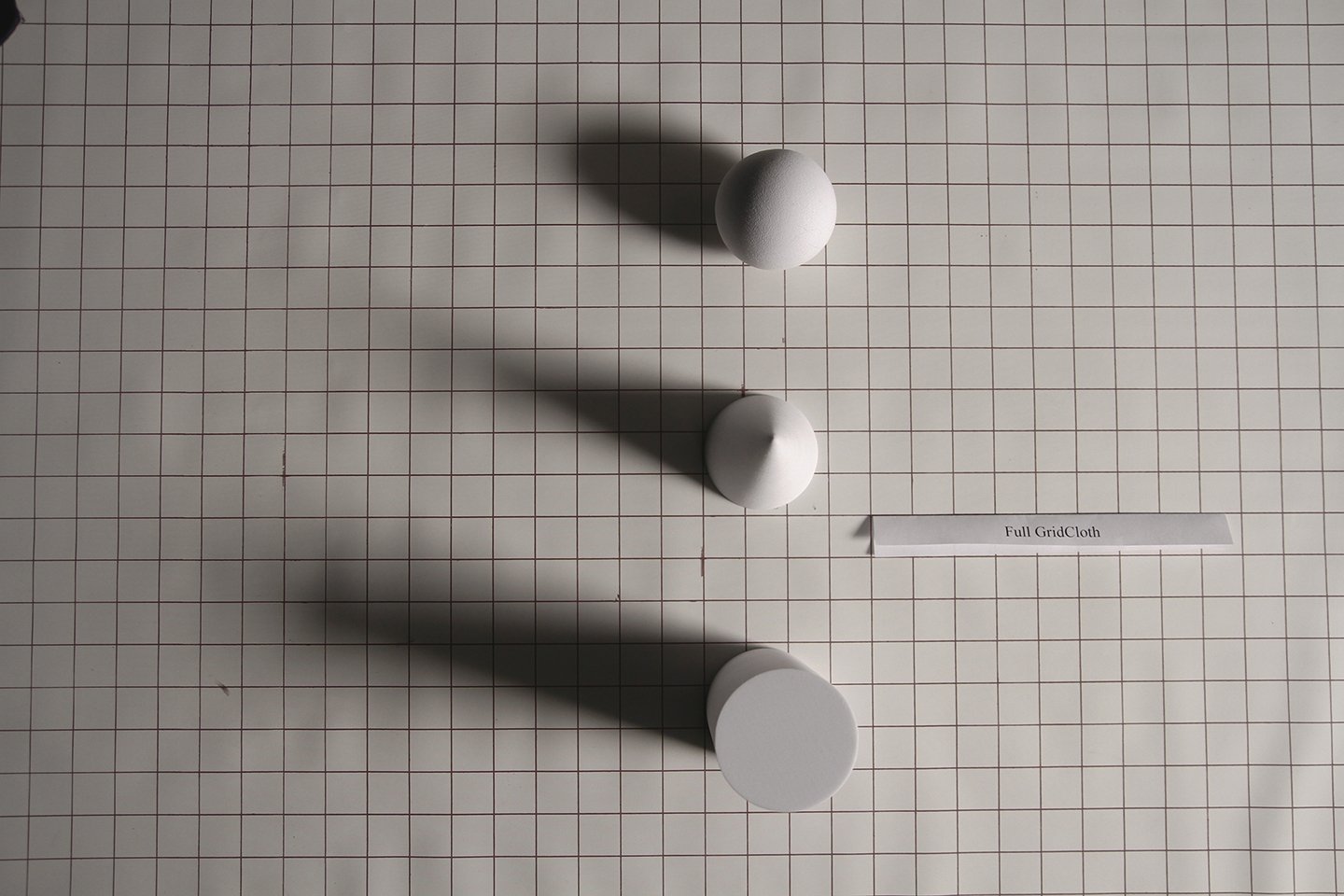
Not every light can easily be made into a hard source, but any light can be made into a soft — or at least a softer — source by adding diffusion material or by bouncing.
